Community Profile: Federal Funds, Tax Increase Help Owensboro Shore Up Its Economy
Photo Gallery | Article
Photo Gallery
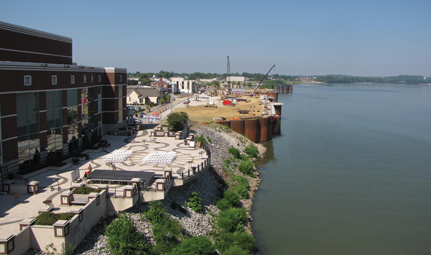
With $40 million in federal aid, the city put in a new retaining wall to halt erosion of downtown by the Ohio River. That project spurred redevelopment of much of downtown. Photo provided by the City of Owensboro
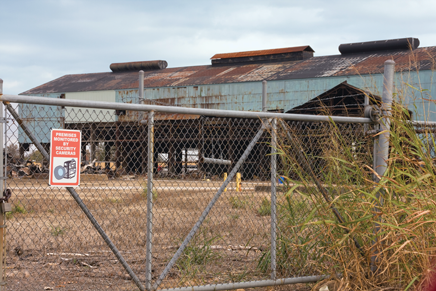
Emblematic of the old economy is the now-shuttered Green River Steel Co. plant. It is being razed. Photo provided by Susan C. Thomson
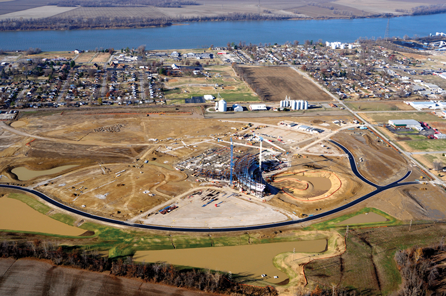
The Owensboro Medical Health System is building a $385 million hospital, which will have 447 beds, almost 100 more than in the current hospital. Photo by Charles Mahlinger
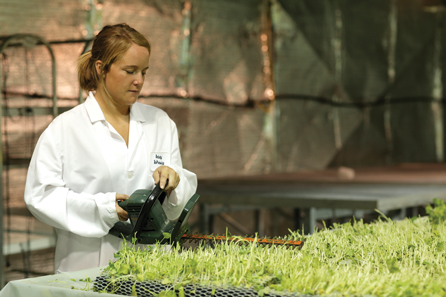
At Kentucky BioProcessing, greenhouse manager Jennifer Poole harvests tobacco plants. The plants undergo an extensive process to purify and extract proteins for use in vaccines and other medicine. Photo by Charles Mahlinger
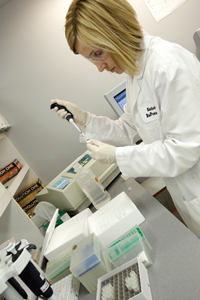
A lab technician at Kentucky BioProcessing, Jill Atherton, prepares to test proteins. Photo by Charles Mahlinger
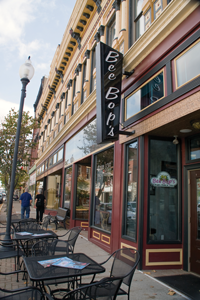
Not everything is new in downtown Owensboro. Many of the older buildings, some dating to the mid-19th century, have been renovated for second-level condos and street-level retail. Photo by Susan C. Thomson
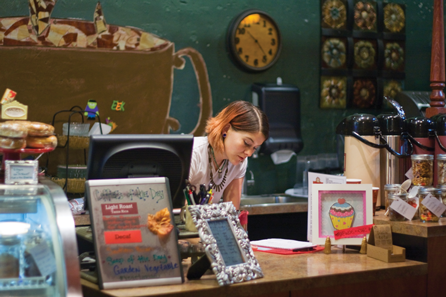
At Creme, a downtown coffee shop, Kelly Creed tends the counter. Creme is one of several properties developed by Larry and Rosemary Conder. Photo by Susan C. Thomson
For years, the Ohio River had been washing away the waterfront park in Owensboro, Ky., threatening to eventually submerge the downtown streets behind it. A $40 million federal erosion-control project secured by U.S. Sen. Mitch McConnell, R-Ky., has stopped the destruction. A new steel containment wall has been sunk into the riverbed at the water's old edge. Tons of dirt have been hauled in and graded, restoring the wasted bank.
Inspired by the announcement in 2005 of the federal funds, civic leaders got serious about redeveloping the wider riverfront area, a subject of off-and-on discussion since World War II. In late 2008, a bold master plan for downtown was unveiled. Streets would be rerouted and a pedestrian-friendly plaza created, revitalizing dozens of blocks.
The park would be re-created with a plaza named for McConnell, plus fountains, play areas, a waterfall, a hotel and an indoor "events center."
The elected commissioners of the city and of Daviess County separately approved the plan in early 2009. They also raised taxes to ensure that it would be realized. A four-percentage-point increase in their assessments on premiums for all personal and business insurance other than health is projected to produce the needed $79 million over 20 years.
"This was a remarkable step forward, with the city and county governments, with their different constituencies, coming together for the common good of the community and overcoming the inertia of 65 years," said Owensboro's city manager, William Parrish.
Over those same years, the Owensboro economy has slowly shifted away from manufacturing. In 2001, Green River Steel Co., where hundreds once worked, closed a plant that is now being razed. General Electric Co., where 6,600 people made radio and television tubes in the mid-1960s, was down to 109 employees making motors when it closed in October. Now the economy is more mixed, consisting of "a little of several things," said Jody Wassmer, president of the Greater Owensboro Chamber of Commerce. Among the mid-sized employers he cited are two natural-gas pipeline companies, a meat packer and makers of pasta sauce, auto parts and chewing tobacco.
Nicholas Brake, president of the Greater Owensboro Economic Development Corp., said the area has benefited from "a lot of success from the internal growth of existing companies."
The Owensboro Medical Health System and U.S. Bank illustrate his point. Both are outgrowths of long-time local enterprises that have serendipitously evolved over the years into job-creating powerhouses.
In 2001, after 30 years of mergers and acquisitions, a one-time Owensboro start-up became U.S. Bank's national mortgage-servicing center. By early 2010, it had run out of space for its burgeoning work force. The bank started planning for a new building, one that would accommodate an additional 500 workers. Owensboro was in competition for that building with unidentified larger cities in Kansas and Wisconsin.
Bob Smiley, executive vice president for the mortgage business, admits to rooting for Owensboro because of its "abundance of workers with the right work ethic."
A combination of incentives, speedily arranged, won the day for Owensboro. In a package valued at $1.7 million, the city offered to build an 81,000-square-foot building and lease it back to the bank for 20 years at below-market rates. The company also qualified for state tax credits worth up to $4.5 million, depending on the exact number of jobs created. The building is under construction.
Across town, the Owensboro Medical Health System is building a $385 million hospital, which it is financing itself. The system, the result of two local hospitals that combined in 1995, has grown into a regional enterprise serving 11 counties. In the process, it has taken on 1,200 more employees, including well-paid specialist physicians and other clinical professionals. The chief executive, Jeff Barber, estimated that the system will add 300 jobs before the new hospital opens in 2013 and then a "couple of hundred" new positions after that.
The new hospital will replace the system's existing 360-bed one and provide space for it to operate its full complement of 447 licensed beds. The older building will stay open for, among other uses, outpatient diagnostic and lab services, cancer treatment and research, and degree-completion programs. The last are offered by the system in cooperation with the University of Louisville's School of Nursing and the University of Kentucky's College of Pharmacy.
In 2006, the health system bought the production facilities of then-bankrupt Large Scale Biology Corp. An offshoot of Owensboro's once-thriving tobacco industry, the company developed a unique system using tobacco plants to make proteins for the production of vaccines and other drugs. The purchase was a move not just to secure technology of potential patient benefit but also "to bring employment and economic growth to the area," Barber said.
The state of Kentucky, having identified biosciences as a key future industry, tapped its national tobacco settlement funds to lend the company half of the $6.4 million purchase price.
Brake, the economic development official, forecasts that the company will position Owensboro to eventually become "a really key player in the emerging plant-made pharmaceutical industry as it develops, one of the centers in the world."
Now called Kentucky BioProcessing, the company has signed a collaboration agreement with German pharmaceutical giant Bayer Innovation GmbH and received a $17.9 million contract from the U.S. Department of Defense. In less than five years, it has grown from six employees to 32 and become profitable, said the chairman, Hugh Haydon.
In 2010, the company built a second, 55,000-square-foot building, increasing its plant-growing space more than tenfold and adding to the stunning amount of construction activity around town.
By Brake's calculation, $500 million worth of work is still under way and likely to generate 9,000 jobs over the next three to five years. That money includes $37 million for the last 2.2-mile stretch of the four-lane U.S. Highway 60 bypass under way on the eastern edge of town. Financing is equal parts state and federal stimulus funds.
Gradually, the downtown master plan is being executed, with some tweaking. As an add-on, planners have conceived an international bluegrass museum and performance center. It would be housed in a vacant state office building, replacing a smaller museum. The new place would further capitalize on Kentucky's musical heritage and Owensboro's annual blue-grass festival.
Meanwhile, the master plan's most expensive feature, the events center, has entered the design phase. In October, a Louisiana architectural firm was chosen, from among 26 bidders, to design the $27 million project, which will have flexible spaces that can be used for everything from meetings to concerts to sporting events. The center is projected to open in 2013, as is a 150-bed Hampton Inn & Suites that a local developer has signed on to build next door. As specified in the master plan, the hotel will be built with private funds.
All along, one of the plan's goals has been to leverage the public money involved to spur private investment, some of which had already begun to happen. In 2006, for instance, husband-and-wife entrepreneurs Larry and Rosemary Conder began buying and fixing up downtown buildings, the oldest dating to the mid-19th century. The couple's properties now include a gift shop, a coffee house and a row of four buildings renovated into second-floor condos and street-level retail space, all of it rented. Among the ground-floor tenants is Gambrinus Libation Emporium, an upscale bar run by the Conders' daughter and son-in-law, Adrianne and John Condray.
"Owensboro is fortunate to have city and county leaders that recognized the value of our historic core and riverfront" and were willing to risk their political careers for it, Rosemary Conder said.
The master plan raised doubts; the tax increase roused opposition.
But "after you saw initial success, people stopped listening to the naysayers," said Michael Beckwith, chief financial officer of homegrown First Security Bank.
The bank is another Owensboro success story. After growing through acquisitions,
it had run out of space in its downtown headquarters. Among possible solutions,
it considered moving the operation to Evansville, Ind.
The bank's ultimate decision was to spend $4.5 million to buy and renovate much of a square block of downtown, including a building there that will be its new home. At 28,000 square feet, it will be twice the size of the current one just across the street and allow the bank to double its existing corporate staff of 25.
The deal, announced in September, was sealed by the state's promise of $250,000
in payroll tax credits for the 25 new jobs.
The chance to stay in the emerging new downtown iced the cake. "We thought it was important to be part of that," Beckwith said.
Owensboro, Ky., by the numbers
| POPULATION |
55,745 (1)
|
| LABOR FORCE |
28,003 (2)
|
| UNEMPLOYMENT RATE |
9 percent (2)
|
| PER CAPITA PERSONAL INCOME |
$33,278 (3)
|
| (1) U.S. Bureau of the Census, estimate July 1, 2009 | |
| (2) BLS/HAVER, October 2010, seasonally adjusted | |
| (3) BEA/HAVER 2008 | |
| Top Employers | |
| Owensboro Medical Health System |
3,200(4)
|
| Daviess County Public Schools |
1,755(5)
|
| U.S. Bank Home Mortgage |
1,261(4)
|
| Owensboro Public Schools |
78(5)
|
| Specialty Food Group (meat processing) |
470(5)
|
| (4) Self-reported | |
| (5) SOURCE: Greater Owensboro Economic Development Corp. | |
Related Topics
Views expressed in Regional Economist are not necessarily those of the St. Louis Fed or Federal Reserve System.
For the latest insights from our economists and other St. Louis Fed experts, visit On the Economy and subscribe.
Email Us


